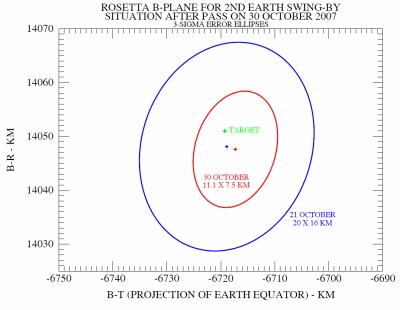No. 89 - First payload activation for second Earth swing-by
Orbit determination and manoeuvre optimisation performed on DoY 302 and 309 confirmed no need for correction manoeuvres on the available slots on DoY 305 and 312.
On DoY 311 the first instruments have been activated for the Earth Swing-by 2 observation campaign.
A total of 14 New Norcia (NNO) passes (5 of which 4 hrs tracking only) were taken during this period. The tracking campaign with DSN stations (DSS) is continuing without problems (11×4hrs tracking passes taken in the reporting period) and will continue till after the Earth Swing-by.
| DOY | Date | Pass | Main Activity |
| 300 | 27/10/07 | NNO 1337 | Tracking Pass |
| 301 | 28/10/07 | DSS-26 1338 | Tracking Pass |
| NNO 1338 | Tracking Pass | ||
| 302 | 29/10/07 | DSS-26 1339 | Tracking Pass |
| NNO 1339 | Tracking Pass | ||
| 303 | 30/10/07 | NNO 1340 | Monitor |
| 304 | 31/10/07 | DSS-26 1341 | Tracking Pass |
| NNO 1341 | Monitor | ||
| 305 | 01/11/07 | DSS-25 1342 | Tracking pass |
| NNO 1342 | Uplink of Earth Swing-by 2 operations timeline | ||
| 306 | 02/11/07 | DSS-15 1343 | Tracking Pass |
| NNO 1343 | Monitor | ||
| 307 | 03/11/07 | DSS-25 1344 | Tracking Pass |
| NNO 1344 | Tracking Pass | ||
| 308 | 04/11/07 | NNO 1345 | Tracking Pass |
| 309 | 05/11/07 | DSS-26 1346 | Tracking Pass |
| NNO 1346 | Tracking Pass | ||
| 310 | 06/11/07 | DSS-26 1347 | Tracking Pass |
| NNO 1347 | Tracking Pass | ||
| 311 | 07/11/07 | DSS-15 1348 | Tracking Pass |
| NNO 1348 | Change of SC configuration for survival mode. First payload activations for ESB2 | ||
| 312 | 08/11/07 | DSS-25 1349 | Tracking Pass |
| NNO 1349 | Monitor | ||
| 313 | 09/11/07 | DSS-26 1350 | Tracking Pass |
| NNO 1350 | Tracking Pass |
At the end of the reporting period (DOY 313) Rosetta was at 3.97 million km from Earth (0.02 AU); one-way signal travel time was 13 seconds. The distance to the Sun was 152 million km (1.01 AU).
Spacecraft
Payload
During the reporting period some of the instruments have started the activities linked to the Earth Swing-by 2 observation campaign.
ALICE
Instrument is OFF.
CONSERT
Instrument is OFF.
COSIMA
Instrument is OFF.
GIADA
Instrument is OFF.
MIDAS
Instrument is OFF.
MIRO
Instrument is OFF.
OSIRIS
Instrument is OFF.
ROSINA
Instrument is ON (RTOF in stand-by) as part of an out-gassing attempt. The instrument will be powered down and up again when crossing Earth's radiation belts. Since DoY 310.12.47 parameter NRNAR152 PSU_Temp_MCP_OS is out of limit (> 50 °C). The PI team confirmed that this is of no concern for the current instrument configuration and that in this configuration the detector can sustain a temperature of 150 °C.
RPC
The MAG instrument was activated on DoY 311.
RSI
Instrument is in muted status.
VIRTIS
Instrument is OFF.
LANDER Philae
The ROMAP instrument was activated on DoY 311.
SREM
Since DoY 248/2007 the accumulation settings are configured for active cruise mode.
Future Milestones
The preparation of the Earth Swing-by phase is proceeding according to plan. The last orbit determination results, indicate that no further trajectory correction manoeuvres are needed unless in the case of catastrophic events. The payload complement will be operating throughout the swing-by phase until 20 November. The closest approach during the swing-by will take place on 13 November at 20:57 UTC.
Earth Swing-by 2 Targeting
In the plot below, the blue cross and surrounding 3-sigma error ellipse were the estimates for the location in the Rosetta B-plane, corresponding to the 2nd Earth swing-by, that were made on the basis of an orbit determination using data from the time of Near Sun Hibernation Mode (NSHM) exit up to the end of the pass on 21 October.
 |
Using data up to the end of the New Norcia pass on 30 October, the red cross and surrounding 3-sigma error ellipse show the current estimate in the B-plane. The location is 3.9 km from the target.
The target location corresponds to a perigee altitude of 5299.5 km (relative to the Earth's equatorial radius). The estimate corresponds to an altitude of 5295.7 km with a 3-sigma uncertainty of 8.8 km.
The estimated time of closest approach (perigee passage) is 20:57:23.0 UTC on 13 November. The 3-sigma uncertainty is now 1.1 seconds.
